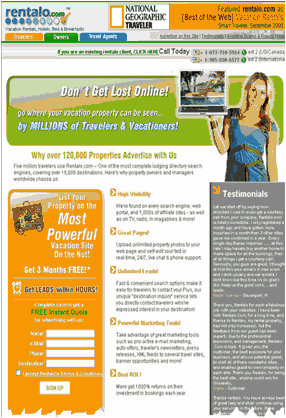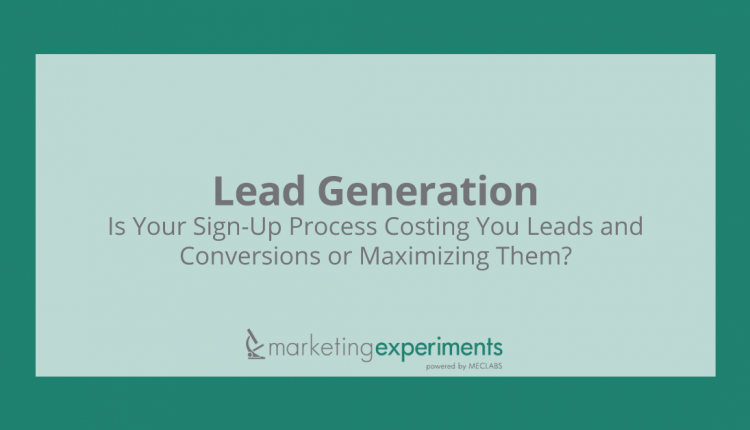Are you missing sales by chasing after Conversions instead of generating leads? Is your website out of sync with your business model?
Getting prospective customers to land on your pages is just the beginning.
You may need to capture leads before you develop relationships. Your products and market may benefit more from a lead-generation approach than from a direct sales strategy.
This brief shares what we discovered about Conversion and lead generation during recent optimization testing with three different research partners. The partners were from three distinct industries, but they shared at least one important characteristic.
Editor’s Note: We recently released the audio recording of our clinic on this topic. You can listen to a recording of this clinic here:
Lead Generation: Is Your Sign-Up Process Costing You Leads and Conversions, or Maximizing Them?
Case Study 1
Test Design
We conducted a 4-week test for a global online vacation rental marketplace. The site is a specialized portal where a subscription path allows vacation property owners (condos, hotels, bed and breakfasts, etc.) to list their rental property and connect with interested travelers.
The objective was to increase the site’s subscription Conversion rate, so we proposed a radical path redesign.
 |
 |
| Control Offer Page | Treatment |
The redesign
- Reduced Friction by decreasing registry fields from four to two and reducing visual over-stimulation;
- Used an instant quote to increase Incentive; a stronger impetus to give us a lead;
- Communicated the Value Proposition more effectively in headlines and copy placement;
- Increased the vertical component of eye-path, directing flow toward the primary call-to-action.
Results
| Page | Offer | Credit Card Payment (Combined w/subscription in treatment) |
Up-sell Options | Confirmation |
|---|---|---|---|---|
| Control | 5,384 | 369 | 3 | 18 |
| Treatment | 5,525 | 458 | 5 | 20 |
| Difference | 41.80% | 66.67% | 11.11% | |
What you need to understand: The Treatment resulted in substantial increases in unique user visits to the credit card and up-sell option pages, but only an 11% increase in Conversion. The sample size was not sufficient at that level of difference (11.11%) to be statistically conclusive.
Observations
During the analysis we compared the Website’s performance against the partner’s other platforms for taking subscriptions and found that most sales were closed by other means.
Even though the partner’s site was designed for direct sales, it was actually functioning mainly as a lead generator. Sales were being closed predominantly by follow-up via telephone and email.
So we returned to the test results and asked another question:
Which version, the Control or the Treatment, generated more leads?
Results
| Page | Lead Capture Rate |
|---|---|
| Control | 6.00% |
| Treatment | 8.29% |
| Relative Difference | 38.2% |
What you need to understand: The Treatment offer path generated a 38% increase in the number of leads captured for the partner to leverage in their follow-up.
Observations
The radical redesign resulted in a simpler, shorter, clearer layout that facilitated Lead Generation.
Sometimes we realize only incremental improvements because we have not asked an important question: What is our primary objective?
In retrospect, the approach of the entire Website needed to be re-examined.
If your product and acquisition model favors “offline” closes, consider the role of your site: Is it better as a lead generator than a Conversion engine?
Sites where the perceived level of investment or purchase risk is high―—or where the process is comparatively complex——are good candidates for a Lead Generation approach.
Case Study 2
Test Design 1
We conducted a two-week A/B split test for a company offering an investment newsletter & trade alert service.
The objective was to increase the site’s Conversion rate to subscription.
The existing subscription path was 5 pages long.
A large amount of traffic was being generated by a TV show where the host directed viewers to a URL to sign-up for the service after they had heard the offer.
We wanted to identify whether eliminating the offer page―—and consequently shortening the path―—would increase the number of subscription sign-ups.
Original subscription path
Results
| Email Capture Rate | Conversion Rate | |
|---|---|---|
| Control | 4.75% | .65% |
| Treatment | 13.99% | .62% |
| Difference | 9.47% | .03% |
While the Conversion rate was statistically unchanged, the relative rate of email capture/lead generation rose by more than 194%.
Observations
The majority of visitors to the site were driven there from the author’s television show, so most arriving prospects were already highly qualified and motivated to purchase. For these people, the long-copy offer page was a source of Friction; especially since it included a large block of legalese―—fine print” close to the call-to-action.
By having customers land on the sign-up page in the Treatment path, we were able to capture more email leads.
There was no mention of price on the first page.
Several sources of Friction were mitigated.
Why did the Treatment path not have a much higher final Conversion rate?
On the second page of the Treatment path customers encountered the same significant sources of Friction that had formerly been on the third page. The second page also contained what our analysts refer to as a “negative surprise”: the price plus “caveat” terms which had been explained on the landing/offer page in the Control path. This caused roughly the same percentage to abandon prior to purchase.
This set the stage for the second test.
Case Study 2
Test Design 2
- We restored the original offer page, but eliminated the check-boxes for Privacy Policy and Terms and Conditions to reduce Anxiety prior to entering the email information.
- We sent a series of basket recovery email messages at 24 hours, 48 hours, 4 days, and 6 days after the initial visit to customers who abandoned their registration after email capture.
- We put a hyperlink in each message that took visitors directly back to the point where they left off, eliminating the need for redundant entry of information
Results
| Email Capture | Conversion Rate | |
|---|---|---|
| Control | 7.32% | .80% |
| Treatment with Email Follow-Up | 10.95% | 1.25% |
| Difference | 3.63% | .45% |
What you need to understand: The Treatment path increased email lead capture by 49%. With the basket-recovery follow-up, the treatment path had a 56% higher relative Conversion.
Key point: capturing email addresses generated leads, allowing the follow-up sequence that increased Conversion.
Optimization testing of the email campaign continues. Further insights may appear in upcoming research briefs.
Case Study 3
Test Design
We conducted two tests, each lasting one week, for an online personality testing organization.
The objective was to design an offer page that would motivate more people to take the assessment. The business also wanted to collect personal information from users, including street address.
The Conversion path was:
Landing page -> Assessment -> Registration -> Profile Results
The treatments that included email capture on the offer page had a separate page asking for a street address before the profile results would be delivered.
Four designs were tested in week 1:
- Long and short offer pages asking for just an email address.
- Long and short offer pages asking for more personal information.
The best page in week 1 became the Control for a micro-test in week 2 designed to verify the primary results.
| Conversion Rate | Leads | |
|---|---|---|
| #1 Short copy—email capture | 25.40% | 426 |
| #2 Long copy—email capture | 23.14% | 346 |
| #3 Short copy—personal info form | 19.95% | 291 |
| #4 Long copy—personal info form | 16.52% | 100 |
| Difference between 1 and 4 | 8.88% | 326 |
What you need to understand: The treatment requiring the least personal information, fewest fields, and shortest copy was 326% better at lead generation than the longest treatment. The Conversion rate was 54% better.
Observations
Consumers are constantly warned against giving personal information to companies. Asking for personal information increased Anxiety.
Presenting a long block of copy for them to read before delivering what they came for increased Friction.
The combination of significantly reducing both Anxiety and Friction in Treatment #1 vs. #4 produced a major increase in lead generation.
Summary
- Re-evaluate your Website. Should you mount a significant lead generation effort?
- In general, products for which the investment or perceived level of risk is high―—or for which the purchase decision is comparatively complex―—are good candidates for a Lead Generation-oriented site approach:
- Determine the information you would like to capture for each customer.
- Determine the absolute minimum amount of information you need to capture “up-front” in order to reduce Anxiety and optimize Conversion.
- Include only the “up-front” information for the initial step of the lead capture process.
- Ask for the additional information you would “like” to collect on the confirmation page or after the initial step.
- If you already have a Conversion-focused site, look at the ratio of sales closed online on the first visit vs. those requiring return visits or intervention contacts through other channels. A large number of abandoned registrations or carts, or intervention contacts may indicate that your site is not providing enough information to make a purchase decision or the level of difficulty is too high. The combination of Motivation, Value Proposition and Incentive are not enough to overcome Friction and Anxiety and lead to Conversion.
- For more information on quantifying the relationship between Motivation, Value Proposition, Incentive, Friction and Anxiety, and their effect on the probability of Conversion, consider our online testing certification course.
Additional Questions
If a user has given you personal information and established a relationship, how do you plan to maximize it?
What’s your plan to continue to provide value, so the relationship is maintained?
Do you have a way to effectively track leads and outcomes?
Related MarketingExperiments Reports:
As part of our research, we have prepared a review of the best Internet resources on this topic.
Rating System
These sites were rated for usefulness and clarity, but alas, the rating is purely subjective.
* = Decent | ** = Good | *** = Excellent | **** = Indispensable
- Sales Lead Generation ***
- Lead Generation Online: Is Your Site a Leaky Bucket? ***
- How to Create High Conversion Lead Capture Pages ***
- 10 Tips for Lead Generation Landing Pages **
- Interactive Advertising Bureau Lead Generation Resource Library **
- Creating a Lead Capture Form for Your Website **
- 7 Tips for Generating Leads Online **
- 2004 Lead Generation and Best Practices Study **
Credits:
Editor(s) — Frank Green
Bob Kemper
Writer(s) — Peg Davis
Gina Townsend
Jimmy Ellis
Bob Kemper
Contributor(s) — Maria Hendricks
Gaby Diaz
Gina Townsend
Jimmy Ellis
Flint McGlaughlin
Bob Kemper
HTML Designer — Cliff Rainer
Email Designer — Holly Hicks



